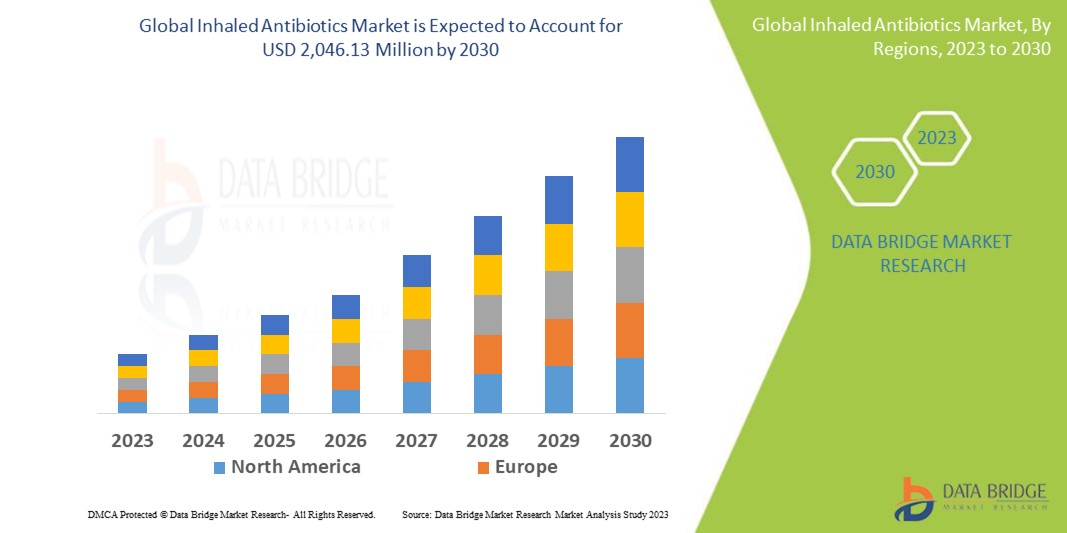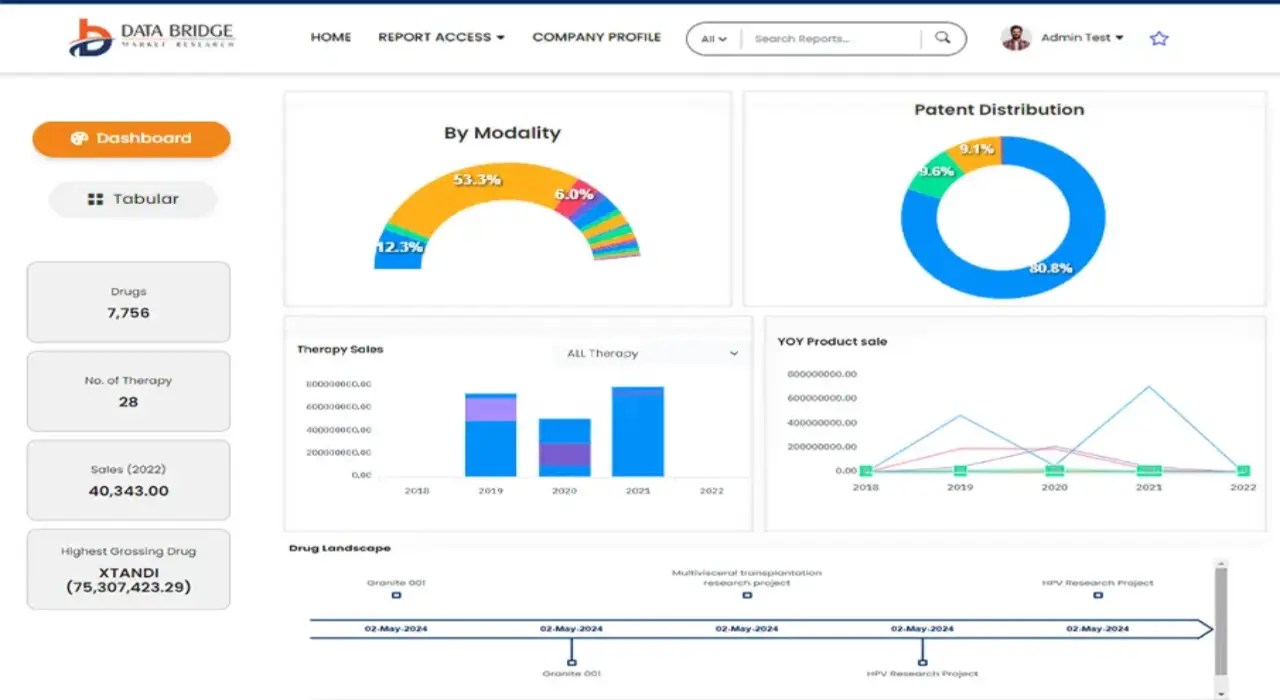Global Inhaled Antibiotics Market
Tamanho do mercado em biliões de dólares
CAGR :
% 
 USD
1,274.12 Million
USD
2,046.13 Million
2022
2030
USD
1,274.12 Million
USD
2,046.13 Million
2022
2030
| 2023 –2030 | |
| USD 1,274.12 Million | |
| USD 2,046.13 Million | |
|
|
|
|
Global Inhaled Antibiotics Market, By Product Type (Dry Powder, Nebulized), Application (Cystic Fibrosis, Bronchiectasis, Ventilator Associated Pneumonia, Others), End-User (Hospitals, Others), Distribution Channel (Hospital Pharmacy, Retail Pharmacy, Others) - Industry Trends and Forecast to 2030.
Inhaled Antibiotics Market Analysis and Size
Inhaled antibiotics are medications that are specifically designed to be delivered directly to the lungs through inhalation. They are used to treat respiratory infections, particularly those caused by bacteria. By delivering the antibiotics directly to the lungs, higher concentrations can be achieved at the site of infection while minimizing systemic side effects. Inhaled antibiotics are commonly used in the treatment of conditions such as cystic fibrosis, Bronchiectasis, and chronic obstructive pulmonary disease (COPD) with recurrent respiratory infections. These conditions often involve the presence of thick mucus in the airways, which can make it difficult for oral or intravenous antibiotics to reach the site of infection effectively.
Data Bridge Market Research analyses that the Inhaled Antibiotics market which was USD 1,274.12 million in 2022, would rocket up to USD 2,046.13 million by 2030, and is expected to undergo a CAGR of 6.1% during the forecast period. This indicates that the market value of dry powder dominates the product type segment of the inhaled antibiotics market owing to the increasing prevalence of antibiotic. In addition to the insights on market scenarios such as market value, growth rate, segmentation, geographical coverage, and major players, the market reports curated by the Data Bridge Market Research also include depth expert analysis, patient epidemiology, pipeline analysis, pricing analysis, and regulatory framework.
Inhaled Antibiotics Market Scope and Segmentation
|
Report Metric |
Details |
|
Forecast Period |
2023 to 2030 |
|
Base Year |
2022 |
|
Historic Years |
2021 (Customizable to 2014-2019) |
|
Quantitative Units |
Revenue in USD Million, Volumes in Units, Pricing in USD |
|
Segments Covered |
Product Type (Dry Powder, Nebulized), Application (Cystic Fibrosis, Bronchiectasis, Ventilator Associated Pneumonia, Others), End-User (Hospitals, Others), Distribution Channel (Hospital Pharmacy, Retail Pharmacy, Others) |
|
Countries Covered |
U.S., Canada and Mexico in North America, Germany, Italy, U.K., France, Spain, Netherland, Belgium, Switzerland, Turkey, Russia, Rest of Europe in Europe, China, India, South Korea, Australia, Singapore, Malaysia, Thailand, Indonesia, Philippines, Rest of Asia-Pacific (APAC) in the Asia-Pacific (APAC), South Africa, Saudi Arabia, UAE, Egypt, Israel, Rest of Middle East and Africa (MEA) as a part of Middle East and Africa (MEA), Brazil, Argentina and Rest of South America as part of South America. |
|
Market Players Covered |
Gilead Sciences (U.S.), Aradigm (U.S.), Lupin Ltd (India), Polyphor, Insmed Incorporated (U.S.), Pharmaero (Denmark), Savara Pharmaceuticals (U.S.), Joincare Pharmaceutical Group (China), Pharmaxis Ltd (Australia), Teva Pharamceuticals (Israel) |
|
Market Opportunities |
|
Market Definition
Inhalation antibiotics are used to treat chronic respiratory airway infections. These inhaled antibiotics are considered more effective than other routes as they deliver high amounts of drugs to the targeted site, which may also drive the inhaled antibiotics market growth.
Global Inhaled Antibiotics Market Dynamics
Drivers
- Increasing prevalence of respiratory infections
Respiratory infections, such as cystic fibrosis, bronchiectasis, and COPD, continue to be a significant healthcare burden globally. The rising prevalence of these conditions drives the demand for effective treatments, including inhaled antibiotics.
- Increasing antibiotic resistance
The emergence of antibiotic-resistant bacteria poses a significant challenge in the treatment of respiratory infections. Inhaled antibiotics can provide localized therapy directly to the lungs, helping to combat these resistant strains and improve treatment outcomes.
- Improved drug delivery systems
Advances in drug delivery systems, such as nebulizers and inhaler devices, have enhanced the efficiency and convenience of administering inhaled antibiotics. These advancements have made the treatment more accessible and user-friendly, contributing to market growth.
- Favorable regulatory environment
Regulatory agencies recognize the importance of inhaled antibiotics in treating respiratory infections, particularly in conditions like cystic fibrosis. They have established guidelines and expedited pathways for the development and approval of inhaled antibiotic therapies, which promotes innovation and market expansion.
Opportunities
- Growing awareness and diagnosis
Increased awareness among healthcare professionals about the benefits of inhaled antibiotics and improved diagnostic capabilities contribute to earlier identification and treatment of respiratory infections. This drives the demand for inhaled antibiotics as a targeted and effective treatment option.
- Expansion in emerging markets
Growing healthcare infrastructure and increasing investments in emerging markets create opportunities for the expansion of the inhaled antibiotics market. These regions often experience a rising burden of respiratory infections, leading to greater demand for effective treatment options.
Restraints/Challenges
- Limited range of indications
Currently, inhaled antibiotics are primarily used in the treatment of respiratory infections associated with conditions such as cystic fibrosis, bronchiectasis, and COPD. The market is somewhat limited by the specific indications for which these antibiotics are approved. Expanding the range of indications could significantly increase the market potential.
- High development costs
The development of inhaled antibiotics requires substantial investment in research, clinical trials, and manufacturing processes. The costs associated with developing new formulations, drug delivery systems, and ensuring regulatory compliance can be significant, making it challenging for smaller pharmaceutical companies to enter the market.
This inhaled antibiotics market report provides details of new recent developments, trade regulations, import-export analysis, production analysis, value chain optimization, market share, the impact of domestic and localized market players, analyses opportunities in terms of emerging revenue pockets, changes in market regulations, strategic market growth analysis, market size, category market growths, application niches and dominance, product approvals, product launches, geographic expansions, technological innovations in the market. To gain more info on the Inhaled Antibiotics market contact Data Bridge Market Research for an Analyst Brief, our team will help you take an informed market decision to achieve market growth.
Recent Developments
- In November 2022, Quadripartite launched a new platform to tackle antimicrobial resistance threats to human and animal health and ecosystems. The Antimicrobial Resistance Multi-Stakeholder Partnership Platform was launched today to ensure the growing threats and impacts of antimicrobial resistance are addressed globally.
- In December 2021, Roche launched the first infectious disease tests and cobas omni Utility Channel for use on the cobas® 5800 System in countries accepting the CE Mark
Global Inhaled Antibiotics Market Scope
The inhaled antibiotics market is segmented on the basis of product type, application, end user and distribution channel. The growth amongst these segments will help you analyze major growth segments in the industries and provide the users with a valuable market overview and market insights to help them make strategic decisions for identifying core market applications.
Product Type
- Dry Powder
- Nebulized
Application
- Cystic Fibrosis
- Bronchiectasis
- Ventilator Associated Pneumonia
- Others
End User
- Hospitals
- Others
Distribution Channel
- Hospital Pharmacy
- Retail Pharmacy
- Others
Inhaled Antibiotics Market Regional Analysis/Insights
The inhaled antibiotics market is analysed and market size insights and trends are provided by country, product type, application, end user and distribution channel as referenced above.
The countries covered in the Inhaled Antibiotics market report are U.S., Canada and Mexico in North America, Germany, Italy, U.K., France, Spain, Netherland, Belgium, Switzerland, Turkey, Russia, Rest of Europe in Europe, China, India, South Korea, Australia, Singapore, Malaysia, Thailand, Indonesia, Philippines, Rest of Asia-Pacific (APAC) in the Asia-Pacific (APAC), South Africa, Saudi Arabia, UAE, Egypt, Israel, Rest of Middle East and Africa (MEA) as a part of Middle East and Africa (MEA), Brazil, Argentina and Rest of South America as part of South America.
North America is expected to dominate the inhaled antibiotics market because of the increasing prevalence of respiratory infections in the region. Growing investment in healthcare infrastructure is also boosting the growth of the market.
Asia-Pacific is expected to witness significant growth during the forecast period of 2023 to 2030 due to the increasing prevalence of hospital-acquired infections (HAIs), the rise in community-acquired infections, the aging population and chronic diseases in the region.
The country section of the report also provides individual market impacting factors and changes in regulation in the market domestically that impacts the current and future trends of the market. Data points like down-stream and upstream value chain analysis, technical trends and porter's five forces analysis, and case studies are some of the pointers used to forecast the market scenario for individual countries. Also, the presence and availability of global brands and their challenges faced due to large or scarce competition from local and domestic brands, the impact of domestic tariffs and trade routes are considered while providing forecast analysis of the country data.
Healthcare Infrastructure Growth Installed Base and New Technology Penetration
The inhaled antibiotics market also provides you with a detailed market analysis for every country's growth in healthcare expenditure for capital equipment, installed base of different kinds of products for inhaled antibiotics market, the impact of technology using lifeline curves and changes in healthcare regulatory scenarios and their impact on the inhaled antibiotics market. The data is available for the historic period 2010-2020.
Competitive Landscape and Global Inhaled Antibiotics Market Share Analysis
The inhaled antibiotics market competitive landscape provides details by competitors. Details included are company overview, company financials, revenue generated, market potential, investment in research and development, new market initiatives, global presence, production sites and facilities, production capacities, company strengths and weaknesses, product launch, product width and breadth, application dominance. The above data points provided are only related to the companies' focus related to inhale antibiotics market.
Some of the major players operating in the inhaled antibiotics market are:
- Gilead Sciences (U.S.)
- Aradigm (U.S.)
- Lupin Ltd (India)
- Polyphor, Insmed Incorporated (U.S.)
- Pharmaero (Denmark)
- Savara Pharmaceuticals (U.S.)
- Joincare Pharmaceutical Group (China)
- Pharmaxis Ltd (Australia)
- Teva Pharamceuticals (Israel)
SKU-
Obtenha acesso online ao relatório sobre a primeira nuvem de inteligência de mercado do mundo
- Painel interativo de análise de dados
- Painel de análise da empresa para oportunidades de elevado potencial de crescimento
- Acesso de analista de pesquisa para personalização e customização. consultas
- Análise da concorrência com painel interativo
- Últimas notícias, atualizações e atualizações Análise de tendências
- Aproveite o poder da análise de benchmark para um rastreio abrangente da concorrência
Metodologia de Investigação
A recolha de dados e a análise do ano base são feitas através de módulos de recolha de dados com amostras grandes. A etapa inclui a obtenção de informações de mercado ou dados relacionados através de diversas fontes e estratégias. Inclui examinar e planear antecipadamente todos os dados adquiridos no passado. Da mesma forma, envolve o exame de inconsistências de informação observadas em diferentes fontes de informação. Os dados de mercado são analisados e estimados utilizando modelos estatísticos e coerentes de mercado. Além disso, a análise da quota de mercado e a análise das principais tendências são os principais fatores de sucesso no relatório de mercado. Para saber mais, solicite uma chamada de analista ou abra a sua consulta.
A principal metodologia de investigação utilizada pela equipa de investigação do DBMR é a triangulação de dados que envolve a mineração de dados, a análise do impacto das variáveis de dados no mercado e a validação primária (especialista do setor). Os modelos de dados incluem grelha de posicionamento de fornecedores, análise da linha de tempo do mercado, visão geral e guia de mercado, grelha de posicionamento da empresa, análise de patentes, análise de preços, análise da quota de mercado da empresa, normas de medição, análise global versus regional e de participação dos fornecedores. Para saber mais sobre a metodologia de investigação, faça uma consulta para falar com os nossos especialistas do setor.
Personalização disponível
A Data Bridge Market Research é líder em investigação formativa avançada. Orgulhamo-nos de servir os nossos clientes novos e existentes com dados e análises que correspondem e atendem aos seus objetivos. O relatório pode ser personalizado para incluir análise de tendências de preços de marcas-alvo, compreensão do mercado para países adicionais (solicite a lista de países), dados de resultados de ensaios clínicos, revisão de literatura, mercado remodelado e análise de base de produtos . A análise de mercado dos concorrentes-alvo pode ser analisada desde análises baseadas em tecnologia até estratégias de carteira de mercado. Podemos adicionar quantos concorrentes necessitar de dados no formato e estilo de dados que procura. A nossa equipa de analistas também pode fornecer dados em tabelas dinâmicas de ficheiros Excel em bruto (livro de factos) ou pode ajudá-lo a criar apresentações a partir dos conjuntos de dados disponíveis no relatório.














